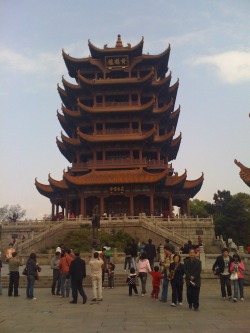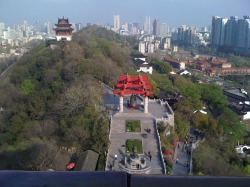Next Monday, 5th April, is the Qing Ming Festival, which has been observed by the Chinese dating back hundred years ago. Qing Ming is not a festival for celebration, but a day of mourning for their ancestors, and in the modern time, for their passed away family members or close relatives.
The Qing Ming Festival 清眀节, meaning CLEAR and BRIGHT festival, falls on the 104th days after the winter solstice, which is the 5th day of April each year and in a leap year, on the 4th day of April. This festival is sometimes known as the Tomb Sweeping Day, a day that the Chinese tend their graves of their love ones.
As the Festival signifies the changeover of the season from winter to spring, messy weather is the order of the day and the Festival usually met with drizzles and windiness. This year is no exception, it is drizzling, windy, wet and messy outside, which makes one feels the grief for those who have lost their love ones.
The most famous poem that featured the Festival was the poem entitled “Qingming” by Du Mu 杜牧 of the late Tang Dynasty, one of the two greatest poets of China of all time.
清明时节雨纷纷 / qīng míng shí jié yǔ fēn fēn
路上行人欲断魂 / lù shàng xíng rén yù duàn hún
借问酒家何处有 / jiè wèn jiǔ jiā hé chù yǒu
牧童遥指杏花村 / mù tóng yáo zhǐ xìng huā cūn
The literal translation of the poem in English is:
清明时节雨纷纷
(the time around the Ching Ming Festival drizzling rain falls messily)
路上行人欲断魂
(the tomb sweepers around me on the dirt road up the mountain seems soon to lose their souls (lives) i.e. on the verge of dying)
借问酒家何处有
(I politely asked where is the nearest inn so that I can drown my sorrow in alochol)
牧童遥指杏花村
(the kid cowherd pointed far beyond at Xing Hua village (meaning my sorrow will go on))
The English poetic translation is:
The ceaseless drizzles drip all the dismal day,
So broken-hearted fares the traveler on the way.
When asked where could be found a tavern bower,
A cowboy points to yonder village of the apricot flower.
The poem in Spanish as provided by my friends are respectively as below :
La llovizna apaga con su llanto el Día de los Muertos.
Por el camino de las tumbas vuelan sombras apenadas.
¡Donde habrá una taberna para ahogar tanta tisteza!
Un joven tropero me señala como llegar al pueblo de Xing Hua .” cuentame que piensas.
Un brillo de la estacion cae sin parar.
en el camino el peatón quiere rendirse,
pregunta por un lugar donde haya vino;
y el pastorcillo le responde: en el pueblo de Xinghua.
The Qing Ming Festival 清眀节, meaning CLEAR and BRIGHT festival, falls on the 104th days after the winter solstice, which is the 5th day of April each year and in a leap year, on the 4th day of April. This festival is sometimes known as the Tomb Sweeping Day, a day that the Chinese tend their graves of their love ones.
As the Festival signifies the changeover of the season from winter to spring, messy weather is the order of the day and the Festival usually met with drizzles and windiness. This year is no exception, it is drizzling, windy, wet and messy outside, which makes one feels the grief for those who have lost their love ones.
The most famous poem that featured the Festival was the poem entitled “Qingming” by Du Mu 杜牧 of the late Tang Dynasty, one of the two greatest poets of China of all time.
清明时节雨纷纷 / qīng míng shí jié yǔ fēn fēn
路上行人欲断魂 / lù shàng xíng rén yù duàn hún
借问酒家何处有 / jiè wèn jiǔ jiā hé chù yǒu
牧童遥指杏花村 / mù tóng yáo zhǐ xìng huā cūn
The literal translation of the poem in English is:
清明时节雨纷纷
(the time around the Ching Ming Festival drizzling rain falls messily)
路上行人欲断魂
(the tomb sweepers around me on the dirt road up the mountain seems soon to lose their souls (lives) i.e. on the verge of dying)
借问酒家何处有
(I politely asked where is the nearest inn so that I can drown my sorrow in alochol)
牧童遥指杏花村
(the kid cowherd pointed far beyond at Xing Hua village (meaning my sorrow will go on))
The English poetic translation is:
The ceaseless drizzles drip all the dismal day,
So broken-hearted fares the traveler on the way.
When asked where could be found a tavern bower,
A cowboy points to yonder village of the apricot flower.
The poem in Spanish as provided by my friends are respectively as below :
La llovizna apaga con su llanto el Día de los Muertos.
Por el camino de las tumbas vuelan sombras apenadas.
¡Donde habrá una taberna para ahogar tanta tisteza!
Un joven tropero me señala como llegar al pueblo de Xing Hua .” cuentame que piensas.
Un brillo de la estacion cae sin parar.
en el camino el peatón quiere rendirse,
pregunta por un lugar donde haya vino;
y el pastorcillo le responde: en el pueblo de Xinghua.




 RSS Feed
RSS Feed